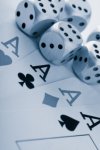Articles
As of the 23rd May 2022 this website is archived and will receive no further updates.
understandinguncertainty.org was produced by the Winton programme for the public understanding of risk based in the Statistical Laboratory in the University of Cambridge. The aim was to help improve the way that uncertainty and risk are discussed in society, and show how probability and statistics can be both useful and entertaining.
Many of the animations were produced using Flash and will no longer work.

 This article is based on a talk I gave at the recent
This article is based on a talk I gave at the recent 
 We use phrases like "the probability of this coin coming up heads is 1/2", and "the odds on Manchester United winning their match are 2 to 1", and "the chance of dying of cancer is 30%". But what do these numbers actually mean? There are fundamentally different views about this, which can lead to very different ideas about how to deal with uncertainty.
We use phrases like "the probability of this coin coming up heads is 1/2", and "the odds on Manchester United winning their match are 2 to 1", and "the chance of dying of cancer is 30%". But what do these numbers actually mean? There are fundamentally different views about this, which can lead to very different ideas about how to deal with uncertainty.